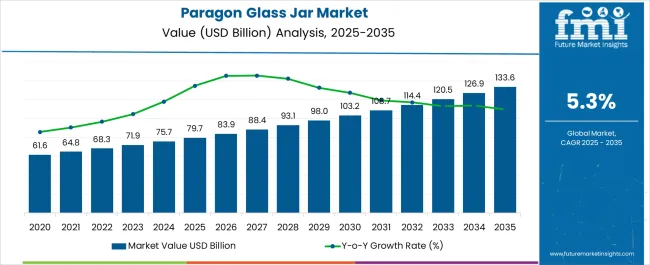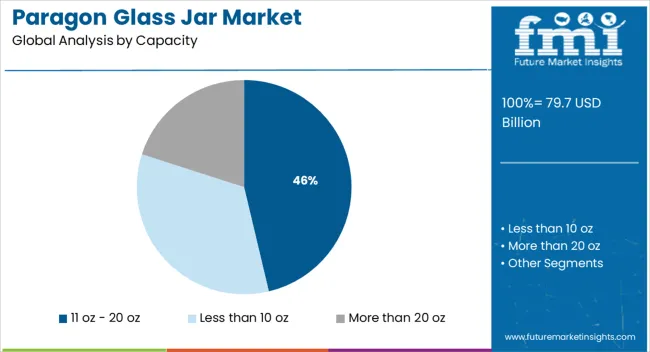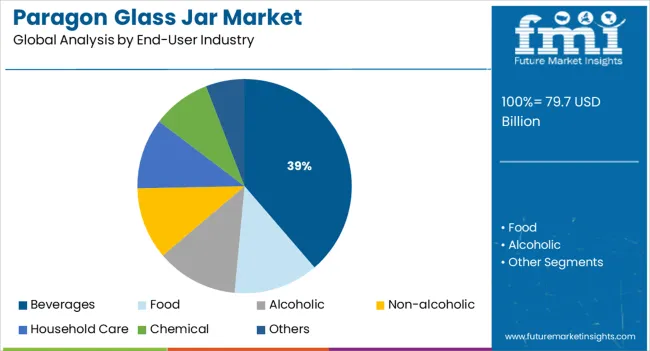The Paragon Glass Jar Market is estimated to be valued at USD 79.7 billion in 2025 and is projected to reach USD 133.6 billion by 2035, registering a compound annual growth rate (CAGR) of 5.3% over the forecast period.

| Metric | Value |
|---|---|
| Paragon Glass Jar Market Estimated Value in (2025 E) | USD 79.7 billion |
| Paragon Glass Jar Market Forecast Value in (2035 F) | USD 133.6 billion |
| Forecast CAGR (2025 to 2035) | 5.3% |
The Paragon glass jar market is witnessing consistent demand across food and beverage packaging applications due to the material’s premium aesthetic, product visibility, and preservation capabilities. Increased consumer awareness regarding sustainable and chemical-free packaging is enhancing the shift toward glass containers.
Innovations in lightweighting and tamper-evident closures are further contributing to performance and cost efficiency, expanding their appeal across mass and niche markets alike. Regulatory efforts promoting the reduction of single-use plastics and a growing focus on recyclability are reinforcing the transition to glass jars in various supply chains.
Additionally, the ability to preserve freshness, resist contamination, and provide an extended shelf-life is supporting the increasing use of Paragon jars for sensitive consumables. Future growth is expected to be influenced by rising demand from artisanal brands, health-conscious consumers, and clean-label product manufacturers seeking packaging that aligns with quality and transparency goals.
The market is segmented by Capacity and End-User Industry and region. By Capacity, the market is divided into 11 oz - 20 oz, Less than 10 oz, and More than 20 oz. In terms of End-User Industry, the market is classified into Beverages, Food, Alcoholic, Non-alcoholic, Household Care, Chemical, and Others. Regionally, the market is classified into North America, Latin America, Western Europe, Eastern Europe, Balkan & Baltic Countries, Russia & Belarus, Central Asia, East Asia, South Asia & Pacific, and the Middle East & Africa.

The 11 oz - 20 oz capacity range is projected to account for 46.3% of total revenue in the Paragon glass jar market by 2025, making it the most preferred size segment. This leadership is being driven by its optimal balance between portability, storage efficiency, and product volume, making it suitable for a wide array of food and beverage products.
Its compatibility with existing filling lines and labeling systems across both manual and automated processes has enhanced operational flexibility for manufacturers. Additionally, the mid-range volume supports portion-controlled packaging and retail convenience, aligning with shifting consumer expectations for functionality and aesthetic appeal.
The segment’s popularity is also reinforced by its adaptability to premium branding and shelf display formats, further increasing its relevance in competitive retail environments.

The beverages segment is expected to hold 38.7% of the Paragon glass jar market share in 2025, positioning it as the leading end-use industry. This dominance is being supported by the growing demand for glass-packaged beverages driven by premiumization trends, taste preservation, and sustainability credentials.
Glass jars are increasingly favored for cold brews, juices, infused waters, and wellness tonics, as they ensure product integrity without chemical leaching or flavor distortion. Rising consumer preference for natural and organic beverages is accelerating the use of glass as a non-reactive packaging material that aligns with clean-label positioning.
Additionally, the recyclability and reusability of Paragon jars provide environmental advantages that are being actively leveraged by beverage brands to build loyalty among eco-conscious customers. This has resulted in elevated adoption across both established and emerging players within the beverage industry.
Paragon glass jar is widely used for canning food products such as jam, spices, and food products. The straight and tall body of paragon glass coupled with a wide dispensing opening makes paragon glass jar adequate to store more food. Paragon glass provide excellent compatibility of materials with high strength. Glass delivers exceptional barrier properties to the food products which are contained in the paragon glass jar.
Due to the elegant looks provided by the paragon glass they are preferred by the end-user industries as well as consumers for household care. The surface of the paragon glass jar can be easily printed with different printing techniques such as screen printing and digital printing. The paragon glass jar usually has the lug finish which contains thin edges and only requires a half turn to seal the container.
The slender body with high length makes paragon glass jar an ideal solution for space saving. Besides, the transparency provided by the glass allows the consumers to clear showcase the product.
The distinct advantages provided by glass packaging such as chemical inertness, high recyclability, non-porosity, and impermeability is expected to propel the global paragon glass jar market. The escalated demand of packaged food products from the end-user industries is anticipated to fuel the global paragon glass jar market.
The paragon glass is extensively used to package food products such as olive oil and jams. The increase in demand for these food products is expected to bolster the paragon glass jar market.
However, the increasing penetration of the plastic and metal packaging across the globe can adversely affect the demand of paragon glass jar. The delicate glass body of paragon glass jar makes their use perilous, especially in the household.
The trend in paragon glass jar market is recycling of glass to produce paragon glass jar. Besides, there are opportunities for the paragon glass jar manufacturers to produce lighter weight paragon glass jar with the similar mechanical properties of conventional paragon glass jar.
Some of the key players operating in the global paragon glass jar market are:
The report is a compilation of first-hand information, qualitative and quantitative assessment by industry analysts, inputs from industry experts and industry participants across the value chain.
The report provides in-depth analysis of parent market trends, macroeconomic indicators and governing factors along with market attractiveness as per segments. The report also maps the qualitative impact of various market factors on market segments and geographies.
Globally, the paragon glass jar market is segmented on the basis of capacity and end-user industries which are further segmented as
The global paragon glass jar market is estimated to be valued at USD 79.7 billion in 2025.
The market size for the paragon glass jar market is projected to reach USD 133.6 billion by 2035.
The paragon glass jar market is expected to grow at a 5.3% CAGR between 2025 and 2035.
The key product types in paragon glass jar market are 11 oz - 20 oz, less than 10 oz and more than 20 oz.
In terms of end-user industry, beverages segment to command 38.7% share in the paragon glass jar market in 2025.






Our Research Products

The "Full Research Suite" delivers actionable market intel, deep dives on markets or technologies, so clients act faster, cut risk, and unlock growth.

The Leaderboard benchmarks and ranks top vendors, classifying them as Established Leaders, Leading Challengers, or Disruptors & Challengers.

Locates where complements amplify value and substitutes erode it, forecasting net impact by horizon

We deliver granular, decision-grade intel: market sizing, 5-year forecasts, pricing, adoption, usage, revenue, and operational KPIs—plus competitor tracking, regulation, and value chains—across 60 countries broadly.

Spot the shifts before they hit your P&L. We track inflection points, adoption curves, pricing moves, and ecosystem plays to show where demand is heading, why it is changing, and what to do next across high-growth markets and disruptive tech

Real-time reads of user behavior. We track shifting priorities, perceptions of today’s and next-gen services, and provider experience, then pace how fast tech moves from trial to adoption, blending buyer, consumer, and channel inputs with social signals (#WhySwitch, #UX).

Partner with our analyst team to build a custom report designed around your business priorities. From analysing market trends to assessing competitors or crafting bespoke datasets, we tailor insights to your needs.
Supplier Intelligence
Discovery & Profiling
Capacity & Footprint
Performance & Risk
Compliance & Governance
Commercial Readiness
Who Supplies Whom
Scorecards & Shortlists
Playbooks & Docs
Category Intelligence
Definition & Scope
Demand & Use Cases
Cost Drivers
Market Structure
Supply Chain Map
Trade & Policy
Operating Norms
Deliverables
Buyer Intelligence
Account Basics
Spend & Scope
Procurement Model
Vendor Requirements
Terms & Policies
Entry Strategy
Pain Points & Triggers
Outputs
Pricing Analysis
Benchmarks
Trends
Should-Cost
Indexation
Landed Cost
Commercial Terms
Deliverables
Brand Analysis
Positioning & Value Prop
Share & Presence
Customer Evidence
Go-to-Market
Digital & Reputation
Compliance & Trust
KPIs & Gaps
Outputs
Full Research Suite comprises of:
Market outlook & trends analysis
Interviews & case studies
Strategic recommendations
Vendor profiles & capabilities analysis
5-year forecasts
8 regions and 60+ country-level data splits
Market segment data splits
12 months of continuous data updates
DELIVERED AS:
PDF EXCEL ONLINE
Glass Rolling Forming Machine Market Size and Share Forecast Outlook 2025 to 2035
Glass Liquor Bottle Market Size and Share Forecast Outlook 2025 to 2035
Glass Bottles Market Forecast and Outlook 2025 to 2035
Glass Laser Engraving Machine Market Size and Share Forecast Outlook 2025 to 2035
Glass Restoration Kit Market Size and Share Forecast Outlook 2025 to 2035
Glass Bottle and Container Market Forecast and Outlook 2025 to 2035
Glass Additive Market Forecast and Outlook 2025 to 2035
Glass Reactor Market Size and Share Forecast Outlook 2025 to 2035
Glass Cosmetic Bottle Market Size and Share Forecast Outlook 2025 to 2035
Glass & Metal Cleaner Market Size and Share Forecast Outlook 2025 to 2035
Glass Product Market Size and Share Forecast Outlook 2025 to 2035
Glassine Paper Market Size and Share Forecast Outlook 2025 to 2035
Glass Container Market Size and Share Forecast Outlook 2025 to 2035
Glass Fibre Yarn Market Size and Share Forecast Outlook 2025 to 2035
Glass Cloth Electrical Insulation Tape Market Size and Share Forecast Outlook 2025 to 2035
Glass Bonding Adhesive Market Size and Share Forecast Outlook 2025 to 2035
Glass Mat Thermoplastic Market Size and Share Forecast Outlook 2025 to 2035
Glass Table Bacteria Tank Market Size and Share Forecast Outlook 2025 to 2035
Glassine Paper Industry Analysis in Western Europe Size and Share Forecast Outlook 2025 to 2035
Glassine Paper Industry Analysis in Korea Size and Share Forecast Outlook 2025 to 2035

Thank you!
You will receive an email from our Business Development Manager. Please be sure to check your SPAM/JUNK folder too.
Chat With
MaRIA